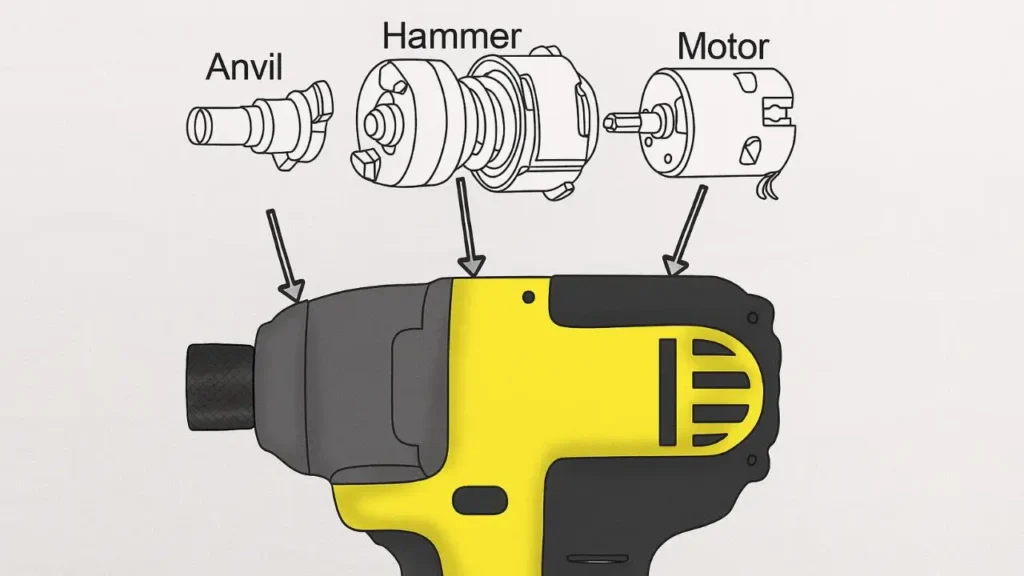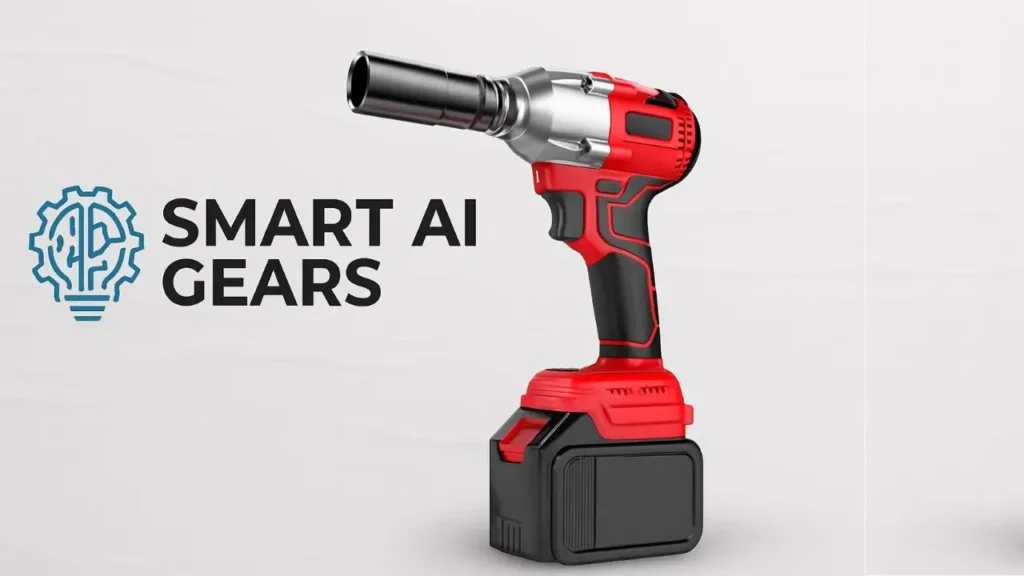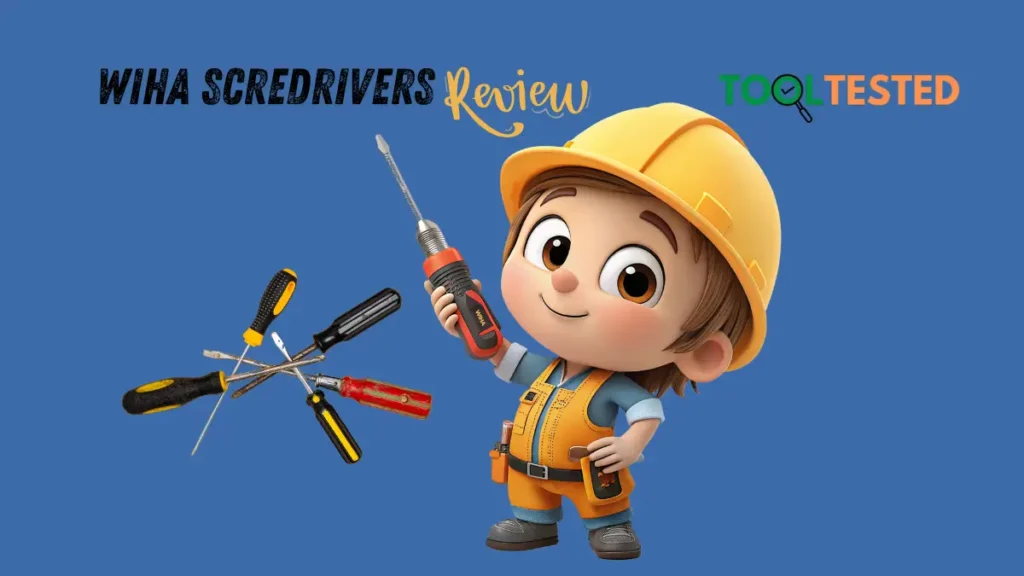Quick Summary: Everything You Need to Know About Screwdriver Impact Tools
- Content Type: Guide
- Last Updated: July 12, 2025
- Fact-Checked By: Author Himself
- Best For: DIY enthusiasts and woodworkers who need to drive long screws or lag bolts into tough materials.
- What’s Great: It delivers immense torque in powerful bursts, making it easy to drive long fasteners with minimal effort.
- What’s Not: Its lack of a clutch makes it unsuitable for precision tasks, and it can easily damage soft materials or small screws.
- Buy If: You frequently build decks, assemble furniture, or work with large fasteners and want to save time and effort.
- Avoid If: Your work primarily involves small fasteners or delicate materials that require precise torque control.
- Affiliate Link Present: Yes
- Available At: You can find it at big-name hardware chains, DIY supply outlets, and trusted online tool shops.
A screwdriver impact tool can hit with bursts of force as fast as 50 times each second when it meets resistance.
These tools pack a punch by mixing rotation with hammer-like force, driving screws faster and with less effort. So, what is an impact driver? It is a tool that changes the game by providing double the torque of regular drills making it essential for both DIYers and pros.
If driving long screws into hard materials has ever given you trouble learning how an impact screwdriver works can make the job much easier. Unlike standard screwdrivers, impact drivers deliver strong torque ranging anywhere from 400 to 2,500 inch-pounds. This power makes them essential for harder more challenging projects.
But what is an impact driver used to do, and when is it better than a regular screwdriver? In this guide, we’ll break down the screwdriver versus impact driver comparison, explain how to use an impact driver , and help you decide which tool you should keep in your kit. Let’s jump into what makes these tools such powerful additions to any DIY project!
Disclaimer
Affiliate Disclaimer
I want to be 100% honest with you. Some links you see in my post are ‘affiliate links’. This just means if you click one of my links and then buy a tool, I get a very small money from the shop.
This does not cost you any extra money at all. The price is the same for you.
This small help lets me keep this blog alive and test more tools for you. Please know, I only link to tools I have used myself or received a verified review of the tool and believe are good. My words and my review are my own, nobody pays me to say nice things. Thank you for your support!
Image Information
All product images used in this post are provided by the author and claimed to be their own usage. According to the author, these images are either self-clicked, taken during hands-on testing, or screenshots captured for review purposes Or their own images converted for with the help of AI for better resolutions. If you believe any image violates your rights, please contact us for proper credit or removal.
Price & Stock Information
The product prices and availability mentioned in this post are accurate as of the time of publishing. However, prices may change on the seller’s website without notice. Please always check the latest price and stock status on the official product page before making a purchase decision.
Best Situations and Projects for Using an Impact Driver
A screwdriver impact tool proves essential in many home or workshop projects because of its wide range of uses. Knowing what these powerful tools do best lets you get the most out of them.
Things you can do yourself at home
Impact drivers work great for everyday home tasks. Use them to put together furniture with big screws, install shelves, or build outdoor things like pergolas or sheds. They also help with hanging cabinets putting up TVs, or assembling playsets. They stop screw heads from getting stripped and make tasks easier by reducing how much effort you need. Since they’re small, they fit into tight spots, which is super helpful in cramped places.
Construction and woodworking
People who build things for work or as a serious hobby find impact drivers most useful in tough construction jobs. These tools are handy for demanding tasks.
- Constructing decks, fences, and wood floors
- Putting up framing and drywall panels
- Screwing into tough hardwood materials
- Constructing outdoor structures
High torque provides the power to drive multiple screws without wearing out your energy. A lot of current 18V models can handle hundreds of 3-inch screws in one charge, which makes them great for bigger tasks.
Uses in automotive and mechanical work
Outside of woodworking, impact drivers hold great importance in mechanical tasks. They work well in vehicle repairs especially to loosen rusted or stuck bolts. You can use socket adapters to turn them into small impact wrenches, which are ideal to handle smaller fasteners under 3/8″. While they don’t match the power of full-sized impact wrenches, they’re still flexible enough to tackle plenty of car-related jobs.
What is an impact driver used for?
Impact drivers work best when you need a lot of torque and power. Their hammer mechanism provides quick bursts of torque, which makes them great tools to drive screws into tough materials. People often use them to fasten things , handle self-tapping screws, or loosen tough fasteners. However, these tools are not ideal when working with soft materials short screws, or tasks that demand precision.
To complete multiple types of projects , impact drivers offer a helpful solution. They reduce strain on your wrist while helping you work faster, which DIY users might find worthwhile.
Screwdriver vs Impact Driver: How Are They Different?
When you compare standard screwdrivers and impact drivers, you notice big differences in their design and how they work. These differences will influence which tool works better for certain jobs.

Torque and speed comparison
Standard screwdrivers provide steady torque during use. Manual ones offer between 20-50 inch-pounds, while powered drills with screwdriver bits can reach torque levels of up to 400 inch-pounds. Impact drivers deliver much greater force reaching rotational bursts from 400 to 2,500 inch-pounds under resistance. This happens because when needed, their internal mechanism activates around 50 times every second.
Speed differs too. Electric screwdrivers run at speeds between 400 and 700 RPM with a steady performance. On the other hand, impact drivers retain faster speeds between 800 and 3,000 RPM even while handling tough tasks. This higher speed helps keep the motor from slowing down while working on challenging jobs.
Precision vs power
Your project needs play a big role in picking the right tool. Standard screwdrivers work best in situations like:
- Assembling small or intricate parts that need careful handling
- Working with softer materials or tiny screws
- When tightening too much might harm the material
- Needing specific control over torque
On the other hand, impact drivers shine when brute strength is key. Their pounding motion allows them to drive long fasteners into tough surfaces without damaging screw heads or tiring your arm too much. However, they fall short when precision is required, as most don’t have the clutch systems of regular drill/drivers, which stop screws from going too far in.
Tips to use an impact driver
Impact drivers bring big benefits, but you need to handle them compared to normal tools. Wear hearing protection to protect your ears because the hammering noise can go over 100 decibels and might harm your hearing if you’re around it too long.
Stick to using special impact-rated bits and sockets built to handle the force of this tool. Regular bits can break apart under the pressure, which can make flying shards dangerous. Hold the tool with both hands if you can when loosening tough fasteners to deal with kickback. Also, don’t try drilling with an impact driver unless you’re using bits made for that purpose.
Learning the Tool: How It Functions
The strength of a screwdriver impact tool comes from its clever design. Its inner workings change basic spinning motion into short powerful bursts. Learning how this works shows why these tools are so important in tough jobs.
Hammer and anvil working together

Inside every impact driver, there’s a smart yet simple system at play. Regular drills just use motor power to do their job, but impact drivers do much more. They include three key parts: a hammer, anvil, and spring. The motor spins the hammer, and the anvil connects to the shaft that holds the bit. The spring between these parts is what creates the big bursts of torque.
This small design helps impact drivers stay lightweight while still offering great power. The hammer and anvil setup acts like a mechanical booster producing more force than the motor could on its own.
How do impact screwdrivers work?
When turned on, an impact screwdriver starts off functioning just like a regular drill. The motor keeps the shaft spinning at first. But when resistance builds up:
- The hammer presses on the spring as it rotates.
- Once the tension becomes strong enough, the hammer briefly separates from the anvil.
- The spring lets go of its stored energy in a quick burst.
- The hammer speeds up and slams into the anvil producing a rotational hit.
- This cycle happens more than 50 times each second.
This fast hammering motion gives the tool its signature “tat-tat-tat” noise. The tool turns a straight spring force into a spinning hit. It works like hitting a wrench with a hammer, just on a much smaller scale.
Why it works well to handle tough materials
The superior design of an impact mechanism works better with tough materials because it uses a different way to apply force. One expert compares it by saying, “Using a drill is like pressing your hands against something and shoving. Using an impact driver is like punching it.”
This quick forceful action achieves two important things. It helps the bit stay locked into the fastener cutting down on cam-out and stripped screws. It also takes the strain off your wrists since the internal parts handle the reactive forces instead of your hands absorbing them.
The bursts of force also lower resistance for brief moments letting the bit sink in deeper with every hit. This makes impact drivers useful when working on dense materials like hardwood or treated wood to drive in large fasteners effectively.
Tips to Buy and Use for DIY Fans
To pick the best screwdriver impact tool, you need to keep a few important things in mind that change how well it works and how easy it is to use. If you learn about these details, you can purchase a tool that will work for your DIY tasks for a long time.
Check Tool and its price online
- BRUSHLESS MOTOR delivers 1825 in-lbs of torque and 3400 RPM to drive large diameter screws
- COMPLETE TOUGH FASTENING APPLICATIONS on the jobsite with 30% more torque
- PRO-LEVEL CONTROL and precision with variable speed trigger and 3-speed setting
Now that you know what to look for in an impact driver, see these features in action by reading our complete, hands-on review of the DeWalt DCF845 Impact Driver.
Deciding on voltage and torque
The tool’s power depends on its voltage. Most DIYers find 18V or 20V tools to be a good mix of strength and ease of use. These options offer enough torque to handle most home projects. While 12V models have torque similar to 18V drills in inch-pounds, they weigh less. This lighter design fits about 80% of everyday jobs.
Torque capacity changes a lot. A 12V impact driver gives between 800 and 1,200 inch-pounds, while 18V ones provide 1,350 to 2,250 inch-pounds. To work on cars, using tools with a range of 50 to 400 Nm works well for small vehicles and regular repairs.
Pick models with adjustable speed settings to avoid damaging threads or applying too much force. Professional tools often include 2 or 3 speed levels, and high-end ones add unique modes made for handling different materials.
Battery life and charging time
Lithium-ion batteries work better than older types because they last longer, weigh less, and deliver more power. Their capacity falls between 2.0Ah and 8.0Ah. Batteries with higher amp-hours allow you to use tools for a longer time before recharging.
To keep batteries in good shape, store them at average temperatures, stop using them before they die, and unplug them once charged. Many companies now provide battery systems designed to fit various tools, which helps save space and cut down costs.
Must-have tools and add-ons
Stick to impact-rated accessories since they can handle the pounding action of these tools. Starter kits should include things like driver bits, socket adapters, and nut setters.
Hex-shank drill bits easily slot into the chuck of an impact driver when used for drilling. Good drivers come with quick-release systems that let you swap bits faster making complex tasks more manageable.
Safety tips and care
To stay safe, wear proper safety gear like eye and ear protection since impact drivers can get louder than 100 decibels. Regularly inspect your bits and sockets for any signs of wear or weakness that might cause them to break unexpectedly and pose a safety risk.
Keep your tool in shape by cleaning the vents often so dust doesn’t pile up. Add a bit of oil to moving parts like the chuck every couple of months, based on how much you use it. Stash the driver somewhere dry to stop it from rusting inside and to help it last longer.
Conclusion
Impact drivers are must-have tools for anyone serious about DIY projects. This guide has shown how these devices can provide torque as high as 2,500 inch-pounds making them perfect tools to handle tough jobs.
Their signature “tat-tat-tat” sound comes from the internal hammering system that easily drives screws into hard materials. This makes them far better than simple screwdrivers for tough jobs like building decks or fixing vehicles.
Ultimately, choose regular screwdrivers for precision and impact drivers for power. Picking the right voltage, battery, and impact-rated bits will help you master your toolkit.
Using these tools is also crucial. Wearing proper eye and ear protection, keeping tools in good shape, and picking the right bits can prevent injuries and make your tools last longer. With good care, an impact driver can handle years of hard work without letting you down.
If you’re installing cabinets building a deck, or loosening tough bolts, an impact driver makes fastening tasks much easier. This tool cuts down on strain to your wrists and boosts productivity making it a must-have for casual DIYers and hobbyists who tackle big projects. Add a solid impact driver to your tools—it’ll make future jobs smoother, and your wrists will benefit too.
Key Points
Learn how impact drivers turn frustrating DIY struggles into smooth quick successes.
• Impact drivers apply up to 50 times more force than regular screwdrivers. They can hit 2,500 inch-pounds of torque using fast hammer-and-anvil technology when dealing with hard materials.
- Go for 18V models to get versatility – they combine just the right amount of power and portability handling most DIY jobs and driving loads of screws on a single charge.
- Stick with impact-rated bits and remember safety gear – normal bits might break under the strain of impact drivers, and noise above 100 decibels means hearing protection is a must.
- Impact drivers bring power regular drivers offer precision – use impact drivers on tough materials and longer screws, but grab a standard one for lighter detailed work.
- Taking care of your tools helps them last longer – wipe the vents often, oil the parts once a month, and keep batteries at room temperature to keep them running well.
The main distinction comes down to how they work. Impact drivers use sudden bursts of power to overcome resistance, while regular screwdrivers rely on smooth steady turning. Knowing which tool fits the task helps speed up work and avoid ruining your materials or tools.
FAQs
Q1. How is an impact driver different from a regular screwdriver? An impact driver delivers high torque in quick bursts, making it ideal for heavy-duty jobs like driving long screws. A regular screwdriver provides steady, lower torque for tasks that need precision.
Q2. Are impact drivers a good choice to invest in for DIYers? Yes, they are a fantastic investment for any DIYer who works with long screws or hard materials. They make big jobs like building decks or furniture much faster and easier.
Q3. Can an impact driver handle every screwdriving job? Impact drivers can do a lot, but they are not perfect for everything. They work best on heavy-duty jobs that need a lot of torque. For light work precise tasks, or projects with softer materials, a regular screwdriver is better to avoid breaking or over-tightening the piece you’re working on.
Q4. What voltage should I consider when picking an impact driver for home projects? An 18V or 20V impact driver works well to handle typical DIY tasks at home. These models have enough torque to tackle most household jobs and are still easy to carry and use.
Q5. How can I take care of my impact driver to make it last longer? Clean the vents often to stop dust from building up. Lubricate moving parts every couple of months, and keep the tool in a dry place. For cordless models, avoid letting the battery drain , store batteries in places with moderate temperatures, and stick to chargers recommended by the maker. Always pick impact-rated bits to protect both the driver and the fasteners.




